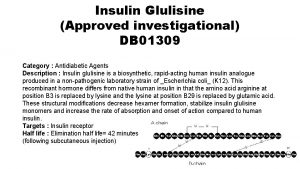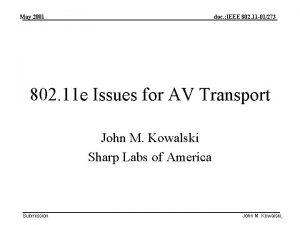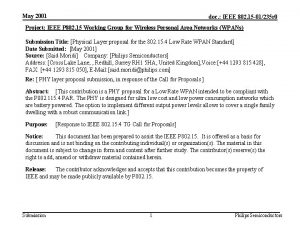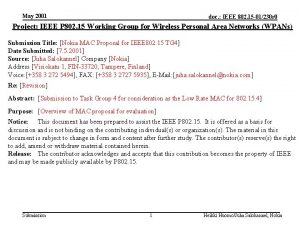May 2001 doc IEEE 802 11 01309 CCKOFDM











- Slides: 11

May 2001 doc. : IEEE 802. 11 -01/309 CCK-OFDM Closing Remarks Mark Webster Steve Halford Jim Zyren Submission 1 Webster & Halford, Intersil

May 2001 doc. : IEEE 802. 11 -01/309 Overview • 802 sees the value of higher rates at 2. 4 GHz – FCC barriers are down – Want backward compatibility • Both proposals recognize value of OFDM • Issue is how to best get there – We feel it is CCK-OFDM not CCK-PBCC-OFDM Submission 2 Webster & Halford, Intersil

May 2001 doc. : IEEE 802. 11 -01/309 CCK-OFDM Proposal • Use. 11 b preamble with 802. 11 a waveform • Optional: Use pure 802. 11 a • Similar to the current use of short preamble • Natural way to: • Provide higher data rates • Provide backward compatibility • Provide convergence with. 11 a Submission 3 Webster & Halford, Intersil

May 2001 doc. : IEEE 802. 11 -01/309 Overview of Performance Issue • OFDM has an advantage against interference • PBCC proposal submission IEEE 802. 1101/286 r 1) shows a huge range advantage for PBCC over OFDM. • We disagree with that conclusion. In a real world environment, OFDM has a range & throughput advantage Submission 4 Webster & Halford, Intersil

May 2001 doc. : IEEE 802. 11 -01/309 TI’s Range Curve IEEE 802. 11 -01/282 150 meters PBCC versus 83 meters OFDM Does this make Sense? 6 Mbps OFDM 5. 5 Mbps PBCC Submission 5 Webster & Halford, Intersil

May 2001 doc. : IEEE 802. 11 -01/309 TI’s Range Curve IEEE 802. 11 -01/282 Path Loss Model After 8 m, assumes indoor path loss exponent of 3. 3: Lpath = – 37. 7 + 10 log(4 p r 3. 3 / l) d. B, r > 8 m Working Backwards from this range ratio: 33 log 10 ( 150 / 83 ) = 8. 5 d. B Advantage ? ? ? ? is shown for 5. 5 Mbps PBCC versus 6 Mbps OFDM How can this be? Submission 6 Webster & Halford, Intersil

May 2001 doc. : IEEE 802. 11 -01/309 OFDM PBCC FEC Codes • OFDM uses the industry standard convolution code for 6 and 12 Mbps. • PBCC uses a code which is equivalent to the industry standard at 5. 5 and 11 Mbps. • Both codes have the same AWGN performance for BPSK and QPSK in Eb/No. Submission 7 Webster & Halford, Intersil

May 2001 doc. : IEEE 802. 11 -01/309 OFDM Performance at 5. 5 and 11 Mbps • OFDM has an extra loss pilot tone loss of 10*log 10(52/48)=0. 347 d. B • OFDM has an extra guard interval loss of 10*log 10(80/64)=0. 969 d. B • OFDM has a pilot tone plus guard interval loss of 1. 32 d. B at 6 and 12 Mbps compared to PBCC at 5. 5 and 11 Mbps Submission 8 Webster & Halford, Intersil

May 2001 doc. : IEEE 802. 11 -01/309 Range Difference for 1. 32 d. B Path Loss Model After 8 m, assumes indoor path loss exponent of 3. 3: Lpath = – 37. 7 + 10 log(4 p r 3. 3 / l) d. B, r > 8 m Manipulating above equation gives: 1. 32 d. B = 33 log 10( R 2/R 1), where R 2 is PBCC range and R 1 is the OFDM range in meters. Solution: R 2 = 1. 09 R 1 Difference translates to a 9% theoretical range advantage at 5. 5 and 11 Mbps in AWGN versus OFDM at 6 and 12 Mbps. Submission 9 Webster & Halford, Intersil

May 2001 doc. : IEEE 802. 11 -01/309 Conclusions on Range • At best, a minimal theoretical range advantage in AWGN. • AWGN is not the limiting factor – What is limiting factor ? -- Multipath • In a real multipath environment OFDM will have the advantage in range and throughput. Submission 10 Webster & Halford, Intersil

May 2001 doc. : IEEE 802. 11 -01/309 Conclusions • CCK-OFDM meets the PAR requirements • CCK-OFDM offers a natural route to OFDM at 2. 4 GHz • CCK-OFDM has lower complexity • CCK-OFDM is a multi-company solution • CCK-OFDM is the best solution for 802. 11 g Submission 11 Webster & Halford, Intersil




















